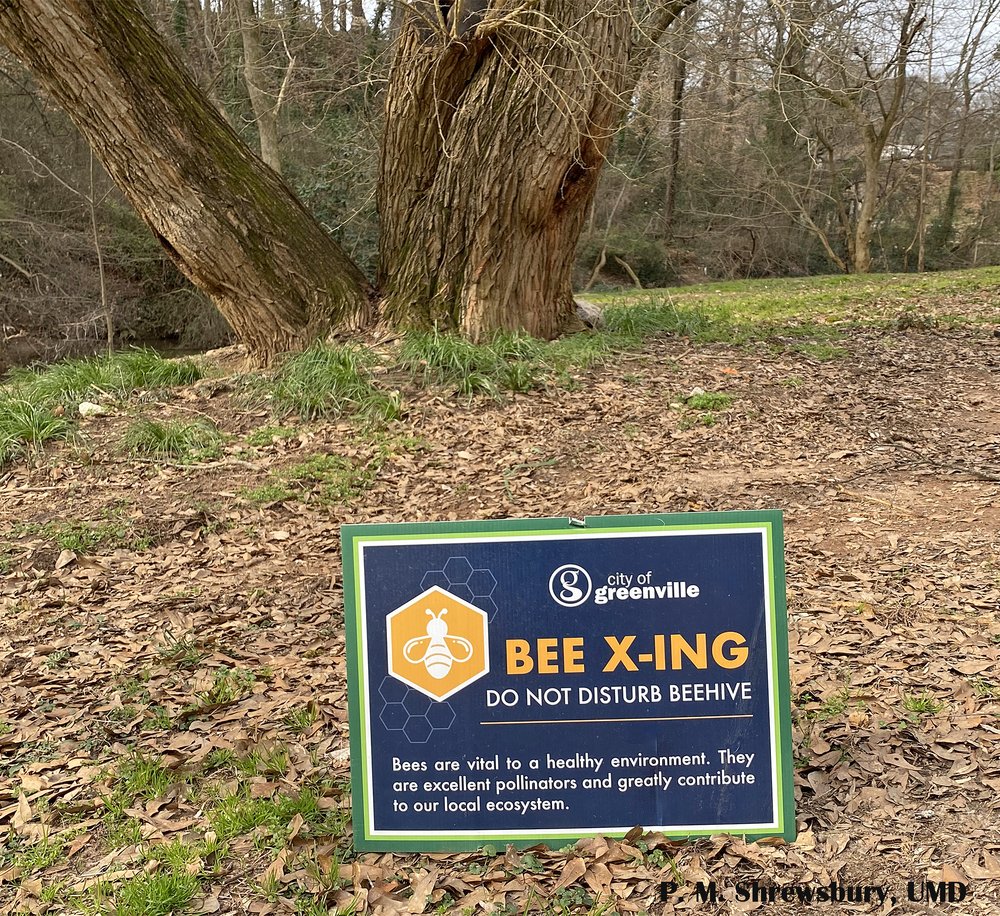How nice to see a bee tree: Honey bees, Apis mellifera

Hairy beggar tick is irresistible to honey bees.
To escape late winter doldrums, recent episodes of Bug of the Week visited Florida’s Everglades to meet creepy smiley face spiders and the largest grasshopper in the US. This week we make a stop in beautiful downtown Greenville, South Carolina, and the Swamp Rabbit Trail. After dining on fresh pastries and fueling up on strong java, it’s time to enjoy an increasingly rare occurrence, honey bees nesting in the cavity of a tree. As Winnie the Pooh knows, honey bees evolved to build hives in natural cavities like tree hollows rather than rectangular boxes built by humans. As a kid growing up in once rural Randolph, New Jersey, it was not unusual to know the location of a few honey bee trees in the forests. However, following the accidental introduction of parasitic Varroa mites into the US in the late 1980’s, both managed and feral honeybees have struggled for survival.
Enjoy one of Mother Nature’s most important pollinators busy at work along the Swamp Rabbit Trail in downtown Greenville, South Carolina. Honey bees made a traditional home in the hollow of an ancient Osage orange tree. Watch as workers return to the hive, leg baskets overflowing with bright yellow pollen, while outbound workers quickly depart to gather new loads of pollen and nectar for their nestmates. Nearby a fragrant white hyacinth seems just the right place to load up on supplies. No humans or honey bees were disturbed or harmed in the making of this video.
Back in 2015, Bug of the Week reviewed several challenges facing our imperiled honey bees. The appearance of a deadly phenomenon called Colony Collapse Disorder, or CCD, grabbed national attention in 2006 when many commercial beekeepers reported unusually large losses of honeybee colonies in several locations in the United States. When CCD strikes a hive, worker bees simply disappear leaving behind the queen, a few young attendant workers, and cells full of pollen and brood. One of the defining characteristics of CCD is the absence of dead bees in the colony. Without a full contingent of hardy workers, the queen and brood are doomed and the colony collapses. Soon after CCD was discovered, national surveys of beekeepers were conducted to determine the magnitude of the problem. Between September 2006 and March 2007, beekeepers lost approximately 32% of their hives. During a similar period in 2007 and 2008, beekeepers in general lost about 36% of their colonies. One important trend in the colony loss phenomenon has been a reduction in losses attributed to CCD. But hives continue to falter and fail.

Interpretive signs alert trail walkers and cyclists to bee-ware of honeybees at work. What a delight to see a bee tree amidst a beautiful urban park and to acknowledge important ecosystem services provided by honey bees. Image: Paula M. Shrewsbury, PhD
What are some of the factors connected with the demise of honey bee colonies in the US? The causes of CCD and hive loss are not fully understood, but researchers have made great progress identifying some of the culprits in this mystery. A recent article by researcher Selina Buckner and colleagues identified a multitude of factors harmful to the health and vitality of honey bee colonies. Factors include those connected to living organisms (biotic factors) and those associated with the non-living environment (abiotic factors). Premier among the biotic factors are invasive parasitic mites and viruses they carry, unhealthy queen honey bees, and variable, scarce, and sometimes unreliable sources of nectar and pollen for bees. On the abiotic side, extreme weather events threaten honey bees and plants on which they depend. Human-made environmental inputs of fungicides and insecticides conspire with these other forces to extinguish hives of honey bees. In a recent summary of surveys connected to honey bee colony loss, scientists discovered that small scale, backyard beekeepers experienced higher rates of winter colony loss, which ranged from 36% to 51% in winters between 2017 and 2020, compared to commercial beekeepers where winter losses ranged from ~ 26% to ~ 32% during the same time frame. By contrast, summer colony losses were generally higher for commercial beekeepers, ranging from ~21% to ~ 28% compared to backyard beekeepers where losses ranged from ~15% to ~22% over three growing seasons. In addition to differences in the size and mode of operation, backyard vs commercial, shifting regional and seasonal patterns of colony loss provide a complex tableau where mites and their associated viruses, queen issues, starvation, and pesticides, along with several other factors, imperil these iconic pollinators here in the US. But circling back to Greenville, SC, where this tale began, what a treasure to behold an Osage orange tree full of busy honey bees along an urban park trail where curious passersby can enjoy one of Mother Nature’s most iconic pollinators at work.
Acknowledgements
Bug of the Week thanks Nathalie Steinhauer and the Bee Informed Partnership for providing information used in this episode. The amazing article “A national survey of managed honey bee colony losses in the USA” by Selina Bruckner, Mikayla Wilson, Dan Aurell, Karen Rennich, Dennis, vanEngelsdorp, Nathalie Steinhauer and Geoffrey R. Williams was used as a resource for this article. Special thanks to Dr. Paula Shrewsbury for images and discovering the bee tree that inspired this episode.
To learn a ton about honey bees, their successes and travails, visit the Bee Informed website on a regular basis: http://beeinformed.org/
This post appeared first on Bug of the Week